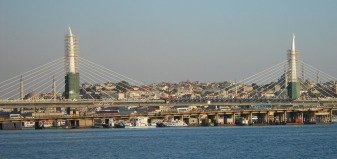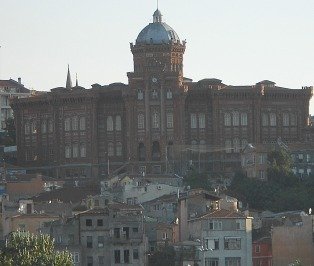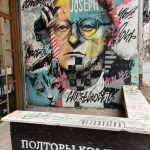The Golden Horn is an estuarine inlet that carves a 7km path from the Alibey and Kağıthan rivers to the Bosphorus, passing between the historic peninsula of Old İstanbul and the lower slopes of Beyoğlu, or New İstanbul. These days taking a cruise along the Bosphorus is more or less de rigueur for visitors to İstanbul. Far fewer people think of cruising along the Golden Horn even though it costs very little and offers a chance to drop in on some very varied inner-city suburbs with some very varied attractions.

Why the Golden Horn? All sorts of reasons have been given for the Golden Horn’s colourful name. Some suggest that the “golden” part was derived from the sheen cast on the water by the rays of the setting sun, others that it harboured a memory of the gold coins hastily tossed into it by the last Byzantines as they awaited the approach of the Ottomans in 1453.
As for the “horn” part, most people assume that it refers to the horn-shaped split at the upper end where the Alibey and Kağıthane rivers flow into the inlet. In more prosaic reality the name was probably taken from the Greek word “chrysokeras” whose own derivation is unclear.
Eschewing all such romanticism, the Turks themselves make do with calling it the Haliç, an abbreviation for Haliç-i Dersaadet, meaning “the Bay of İstanbul” in Osmanlı, the language of the Ottoman Empire.
The Golden Horn ferry route

Ferries along the Golden Horn depart hourly from Üsküdar and Kadıköy, calling into Karaöy to pick up more passengers. Shortly after passing under the Galata Bridge you’ll see the Haliç Bridge that carries the Metro from Şişhane to Yenikapı. Its struts are said to suggest the horns of a cow while its underside is designed to resemble the hull of a boat.
The ferries stop first on the northern shore at Kasımpaşa , a dejected suburb dominated by assorted military installations and a barracks-turned-government office standing on the site of what were once old shipyards. Even if you don’t disembark here you will still be able to admire the statue of Cezayirli Gazi Hasan Paşa (1713-90), an eccentric admiral who kept a pet lion. If you do get off the ferry here, just up the road you can visit the lovely Aynalıkavak Kasrı, a beautiful small palace in extensive gardens beside the water.
Afterwards, you can hop back on again and cross the water to Fener on the southern shore. From the deck of the ferry look out for the huge building in Cibali that now houses the Kadir Has University and a small archaeological museum but which was once a tobacco factory. The deck also offers the best vantage point for viewing the huge red-brick building on top of the hill that houses the Fener Greek High School for Boys (aka the Red Castle).
 The “Red Castle”Fener was once home to the Phanariote Greeks, descendants of the Byzantines who stayed on after the Ottoman Conquest and often rose to high office both in İstanbul and in the Balkan provinces. Of their magnificent brick mansions only a handful survive. The coast road was built on reclaimed land and on the inland side of it you can still make out traces of the old Sea Walls that, with the great Theodosian Land Walls, once guarded the city so carefully.
The “Red Castle”Fener was once home to the Phanariote Greeks, descendants of the Byzantines who stayed on after the Ottoman Conquest and often rose to high office both in İstanbul and in the Balkan provinces. Of their magnificent brick mansions only a handful survive. The coast road was built on reclaimed land and on the inland side of it you can still make out traces of the old Sea Walls that, with the great Theodosian Land Walls, once guarded the city so carefully.
Midway between Fener and Balat stands a real curiosity — the Gothic-style, cast-iron Church of St. Stephen of the Bulgars.  Yavuz Sultan Selim Cami from Golden Horn
Yavuz Sultan Selim Cami from Golden Horn
From Balat the ferry tacks back across the Golden Horn to Hasköy where you can disembark to visit the Rahmi M. Koç Museum, Turkey’s first (and best) industrial heritage museum encompassing the site of another old shipyard and an anchor-making factory.
Then you can hop back on the ferry and cruise to Ayvansaray where the Sea Walls met the Land Walls and one of the best places to get an idea of what the city’s fortifications would have looked like towards the end of the Byzantine period.
The ferry then crosses back to Sütlüce on the northern shore, which is dominated by the huge Haliç Conference Centre housed inside what was once a grim slaughter-house dating back to 1923. From here you can hire a rowing-boat to take you upstream to Miniatürk where children can cast an eye over cut-down models of all Turkey’s major tourist sites.
From Sütlüce the ferry ambles to its last stop at Eyüp right beside the long brick-built Feshane where all the city’s fezes were made. Eyüp is also home to the Eyüp Sultan Cami, İstanbul’s most holy shrine as the burial place of Ebu Eyüp el-Ensari, standard-bearer to the Prophet Mohammed.
The only place to end a tour of the Golden Horn is the famous Pierre Loti Café, built over the site of an original coffeehouse where the Turcophile French novelist Pierre Loti used to come to admire a view that extends over the rustic Bahriye Adaları (Navy Islands) and down the Golden Horn. A cable car runs straight to the top of the hill, then you can walk back down again past a forest of Ottoman gravestones.

Around the Golden Horn

